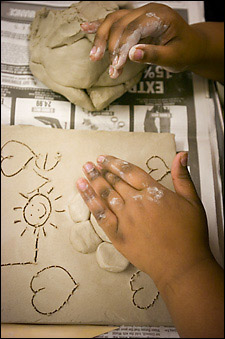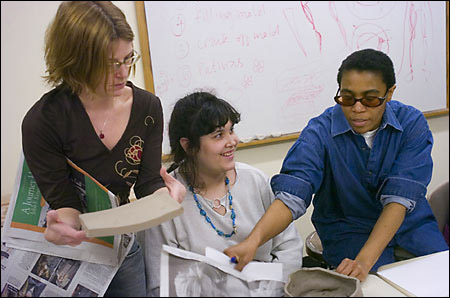Molding women: Power of the arts in shaping strong lives
HGSE students help teen girls create brighter futures

 It is the beginning of class and it is Nia’s turn to say what clay means to her. She glances around the ceramics studio at the circle of teenage girls. They’re standing shoulder to shoulder in front of a table covered with pristine clay tablets just waiting for hands to mold them. “What I like about clay is you can always start over when you mess up, and it can be anything you want it to be,” she says.
It is the beginning of class and it is Nia’s turn to say what clay means to her. She glances around the ceramics studio at the circle of teenage girls. They’re standing shoulder to shoulder in front of a table covered with pristine clay tablets just waiting for hands to mold them. “What I like about clay is you can always start over when you mess up, and it can be anything you want it to be,” she says.
Nia, a 15-year-old from the Boston neighborhood of Mattapan has nicely captured the healing power of working with clay, which has drawn nearly a dozen underserved teenage girls across Boston to Harvard’s Ceramics Studio in Allston this day. The girls, ages 9 to 18, are participants in the spring session of a 20-week arts therapy collaboration aimed at providing them – all of whom have been either witnesses to violence or victims of violence, or are offenders themselves – a chance at a better future.

Class begins. Amid escalating chatter, Nia is entranced, silently rolling out clay tubes with her fingers, then coiling and smoothing the sides of her emerging pot. Other girls are digging words and phrases like “God bless my dad,” “happiness,” or “love” into the clay slabs and adding flowers and hearts. Teacher Kati Blair, a graduate student with the Harvard Graduate School of Education’s (HGSE) Arts in Education program, and Erin Mishkin, HGSE student and volunteer, circulate among the girls. They suggest ideas for projects, demonstrate sculptural strategies, and offer various tactics to solve the problem at hand. Arts Incentives Program mentors provide feedback and encouragement.
An unusual group of people and organizations have come together to offer these girls a weekly retreat. The Arts Incentives Program at the United South End Settlements coordinates the program and provides ongoing counseling for the girls. The Naratoone Security Corporation, which patrols MassHousing developments, helps – through the efforts of Deputy Chief Matt Brevelleri – to identify girls for the program, and provides transportation. Harvard brings the magic of the arts by offering the studio space, ceramics teachers, and experts – and the clay. Last fall, Cambodian artist Yary Livan, a survivor of the Khmer Rouge’s reign of terror and the only remaining master of traditional Cambodian ceramics and kiln building, was guest instructor. Drawing from his own experiences and love of art, Livan brought a special intuition for teaching that helped break down barriers and build the girls’ confidence.
Program coordinators say the program not only provides a positive afternoon activity, but also helps the girls gain a sense of competence and self-worth.

“Working with clay not only feels good and is fun to do, but it gives these girls a sense of pride in their own work,” says Blair, who has been working with girls in the Arts Incentives Program since last fall. “Turning a lump of mud into a project is something physical; they can see what they’ve done.”
Lisa Fliegel, founder and director of the Arts Incentives Program, is convinced that art contributes to mental health and social change. “We are working together to chase down the problems until they are solved.”
Class is almost over. Jessie, a resident of the Academy Projects in South Roxbury picks up her pot, presses it against her cheek and breathes in the smell of the clay. “I like the patience, the creativity,” she says. “You get to do new things that you’ve never done before, … It’s like giving it all the love you never had.”




